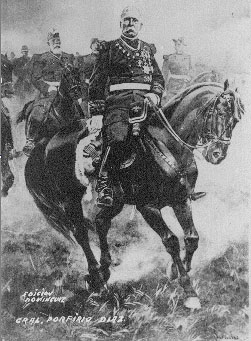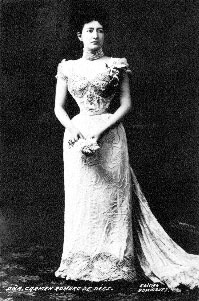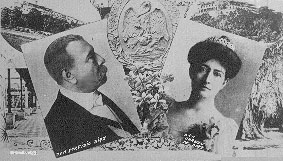|
Porfirio Diaz
Porfirio Diaz (1830-1915) perhaps qualifies as one of
Mexico's most controversial statesmen. President of
the country for 30 years, Diaz is frequently
remembered as being one of the country's most
notorious dictators. The bitter irony to his record
lies in his accomplishments, of which there were many.
Diaz brought Mexico into the modern age and the
country achieved financial solvency under his reign.
 |
|
General Porfirio Diaz, The Military Hero | |
Born in Oaxaca, Mexico, Porfirio Diaz had mestizo
blood. He grew up in the capital of the state, the
city of Oaxaca. The early years of his life were
filled with economic hardship and tragedy. His father
died when he was just three years of age, leaving the
family impoverished. Porfirio's mother, struggling to
raise eight children on her own, nonetheless
recognized the importance of an education and enrolled
Porfirio in the seminary.
However, Porfirio Diaz' destiny lay in the world of
temporal affairs. He switched his studies from the the
priesthood to law. Known to be a diligent student, one
of his tutors was Mexico's future president and
beloved hero, Benito Juarez. Influenced and inspired
by Juarez' commitment to social justice, Diaz' early
allegiance was to the ideals of
liberalism.
Mexico during the second half of the 19th century was
facing internal challenges as well as threats from
abroad. War was in the air and Porfirio abandoned his
studies to become a soldier. In short order, Porfirio
Diaz became known for his bravery, cunning and
ability. He fought valiantly during the War of the
Reform and was promoted for his efforts. His daring
maneuvers during the Battle of Puebla earned him the
title of hero. This famous battle is why Cinco de Mayo
is celebrated today.
Subsequent skirmishes had Porfirio captured and
imprisoned. Walls and guards could not hold him and he
would successfully escape his captors. His
extraordinary abilities on the battlefield earned him
the rank of General and the loyalty of the men who
served under him. His future success was assured with
a career in the military but Porfirio had further
ambitions.
Breaking completely from his former mentor Benito
Juarez, Porfirio ran against his elder for the office
of president. He lost the election but undeterred,
sought the office yet again when another rival
succeeded Juarez, Lerdo de Tejada. Porfirio staged a
rebellion and crafted the "Plan of Tuxtepec", a plan
of governance that mainly rested upon the principle of
a one-term presidential office with reelection
forbidden.
 |
|
Dona Carmen Romero de Diaz, Wife of Porfirio Diaz | |
The subsequent election that followed brought Porfirio
success. He became president in 1877 and served the
remaining one term, abiding by his previously
advertised platform. A hand-picked successor assumed
the office next, Manuel Gonzalez. Chaos and
instability dogged this administration. The next
election saw Porfirio Diaz reneging on his earlier
promise of a one-term presidential office. Porfirio
promptly emerged the winner and assumed office.
From 1884 to 1911 Porfirio Diaz ruled Mexico as a dictator. He quenched all
opposition by violence and intimidation. His reign of office is known as the "Porfiriato". Porfirio
Diaz is credited with the establishment of the "rurales", bandits that the
president heavily armed so that they could carry out
his orders.
The poor and indigenous suffered enormously under the dictatorship of Diaz.
Lands were taken away and the indigenous were forced into a debt-slavery system.
As well, freedom of speech was not tolerated under the "Porfiriato". Hacienda owners however prospered as did
other select groups.
Porfirio and his advisors followed the philosophy of
positivism whose basic tenet prized economic
development no matter what the cost. This philosophy
provided a rationalization for Diaz and his followers,
the cientificos who believed that only when economic
stability is achieved can social progress be made.
 |
|
President Porfirio Diaz and Dona Carmen | |
Indeed, under the reign of Diaz, Mexico prospered
incredibly in terms of over-all economics. Mexico
entered the modern age with electricity brought to the
cities and thousands of miles of railway built.
Factories sprung up and the national debt was paid in
full.
However, the social atrocities occurring in tandem
with these achievements created an unrest that could
not be quenched. The cry of revolution could be heard
throughout the country. Pancho Villa, Emiliano Zapata
and others answered the call. The Mexican Revolution
had begun and Porfirio Diaz was forced to flee the
country. He died in exile.
|